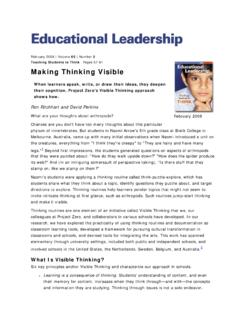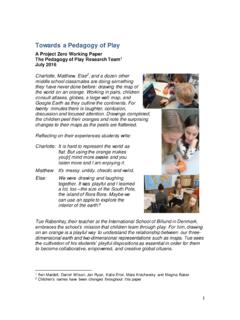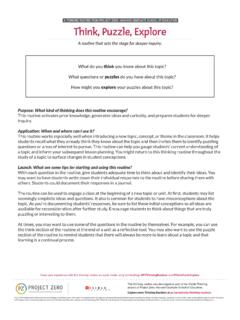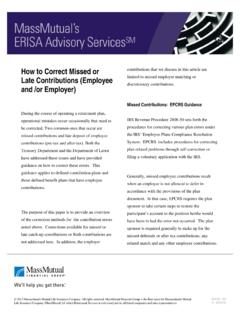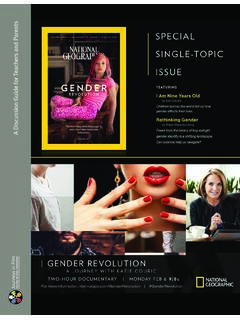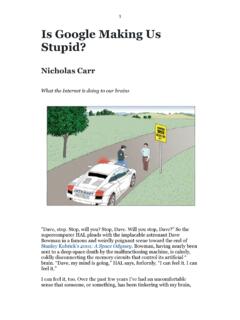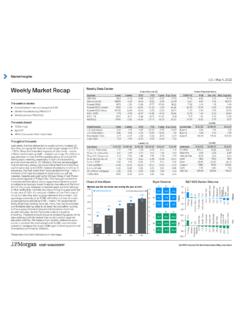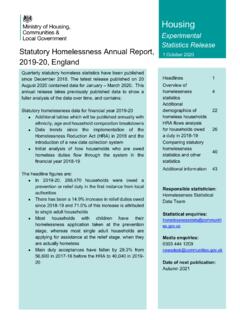Transcription of Making Thinking Visible - Harvard University
1 RoutineKey Thinking MovesNotesRoutines for Introducing & Exploring IdeasSee-Think-WonderDescribing, interpreting, and wonderingGood with ambiguous or complex visual stimuliZoom InDescribing, inferring, and intrepretingVariation of STW involving using only portions of an imageThink-Puzzle-ExploreActivating prior knowledge, wondering, planningGood at the beginning of a unit to direct personal or group inquiry and uncover current understandings as well as misconceptionsChalk TalkUncovering prior knowledge and ideas,questioningOpen-ended discussion on paper. Ensures all voices are heard, gives Thinking BridgeActivating prior knowledge,questioning, and connection makingthrough metaphorsWorks well when students have prior knowledge but instruction will move it in a new direction.
2 Can be done over extended time like the course of a unitCompass PointsDecision Making and planning, uncovering personal reactionsSolicits the group s ideas and reactions to a proposal, plan, or possible decisionExplanation GameObserving details and building explanationsVariation of STW that focuses on identifying parts and explaining them in order to build up an understanding of the whole from its parts and their purposesRoutines for Synthesizing & Organizing IdeasHeadlinesSummarizing, capturing the heartQuick summaries of the big ideas or what stands outCSI: Color, Symbol, ImageCapturing the heart through metaphorsNonverbal routine that forces visual connectionsGenerate-Sort-Connect-Elabora te: Concept MapsUncovering and organizing prior knowledge to identify connectionsHighlights the Thinking steps of Making an effective concept map that both organizes and reveals one s thinkingThe 4 C sConnection Making , identifying key concept, raising questions, and considering implicationsA text-based routine that helps identifies key points of complex text for discussion.
3 Demands a rich text or bookMicro LabFocusing attention, analyzing, and reflectingCan be combined with other routines and used to prompt reflection and discussionI used to thinkReflecting and metacognitionUsed to help learners reflect on how their Thinking has shifted and changed over timeRoutines for Digging Deeper into IdeasWhat makes you say that?Reasoning with evidenceA question that teachers can weave into discussion to push students to give evidence for their assertionsCircle of ViewpointsPerspective takingIdentification of perspectives around an issue or problemStep InsidePerspective takingStepping into a position and talking or writing from that perspective to gain a deeper understanding of itRed Light, Yellow LightMonitoring, identifying of bias, raising questionsUsed to identify possible errors in reasoning, over-reaching by authors, orareas that need to be questionedClaim Support QuestionIdentifying generalizations and theories, reasoning with evidence.
4 Making counter argumentsCan be used with text or as a basic structure for mathematical and scientific thinkingTug of WarPerspective taking, reasoning, identifying complexitiesIdentifying and building both sides of an argument or tension/dilemmaWord-Phrase-SentenceSumma rizing and distillingText-based protocol aimed at eliciting what a reader found important or worthwhile; used with discussion to look at themes and Routines MatrixThinking Routines Matrixfrom Making Thinking Visible by Ron Ritchhart, Karren Morrison & Mark , R., Church, M. & Morrison, K. (2011). Making Thinking Visible : How to promote engagement, understanding, and independence for all learners.
5 San Francisco, CA: Jossey-Bass. (p. 51-52). Harvard GRADUATE SCHOOL OF EDUCATIONE xplore more Thinking Routines at Find more Thinking Routines and application strategies in the Making Thinking Visible and The Power of Making Thinking Visible books.
